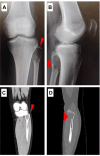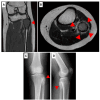Giant Cell Tumor of the Proximal Fibula in a 15-year-old Female: A Review and Case Report
- PMID: 40579013
- PMCID: PMC12223642
- DOI: 10.21873/invivo.14043
Giant Cell Tumor of the Proximal Fibula in a 15-year-old Female: A Review and Case Report
Abstract
Background/aim: Giant cell tumor of the bone (GCTB) is a locally-aggressive, benign tumor that typically affects young adults between 20 and 40 years old.
Case report: A 15-year-old female presented to a primary care physician with pain in the lateral aspect of the left knee and was referred to our department with a suspected bone tumor owing to radiographic findings of osteolysis of the proximal fibula. Computed tomography indicated osteolysis of the proximal fibula, and the bone cortex was thin and partially irregular. Magnetic resonance imaging indicated a mass in the same area, with hyperintense changes in both T1- and T2-weighted images. No biopsy was performed; however, bone tumor curettage and artificial bone grafting were performed. The final pathological examination indicated osteoclastic, multinucleated giant cells. No malignant findings were observed, and the patient was diagnosed with GCTB. No recurrence was observed one year after surgery.
Conclusion: This case highlights the occurrence of GCTB in a young patient at an uncommon location. Oncologic surgeons should consider GCTB as a differential diagnosis when an image shows translucency of the proximal fibula, even if the patient is younger than the usual age of onset.
Keywords: Fibula; case report; child; giant cell tumor of bone.
Copyright © 2025, International Institute of Anticancer Research (Dr. George J. Delinasios), All rights reserved.
Conflict of interest statement
The Authors declare that they have no conflicts of interest to report regarding the present study.
Figures



Similar articles
-
Does Augmenting Irradiated Autografts With Free Vascularized Fibula Graft in Patients With Bone Loss From a Malignant Tumor Achieve Union, Function, and Complication Rate Comparably to Patients Without Bone Loss and Augmentation When Reconstructing Intercalary Resections in the Lower Extremity?Clin Orthop Relat Res. 2025 Jun 26. doi: 10.1097/CORR.0000000000003599. Online ahead of print. Clin Orthop Relat Res. 2025. PMID: 40569278
-
Are Current Survival Prediction Tools Useful When Treating Subsequent Skeletal-related Events From Bone Metastases?Clin Orthop Relat Res. 2024 Sep 1;482(9):1710-1721. doi: 10.1097/CORR.0000000000003030. Epub 2024 Mar 22. Clin Orthop Relat Res. 2024. PMID: 38517402
-
Comparison of Two Modern Survival Prediction Tools, SORG-MLA and METSSS, in Patients With Symptomatic Long-bone Metastases Who Underwent Local Treatment With Surgery Followed by Radiotherapy and With Radiotherapy Alone.Clin Orthop Relat Res. 2024 Dec 1;482(12):2193-2208. doi: 10.1097/CORR.0000000000003185. Epub 2024 Jul 23. Clin Orthop Relat Res. 2024. PMID: 39051924
-
Surveillance of Barrett's oesophagus: exploring the uncertainty through systematic review, expert workshop and economic modelling.Health Technol Assess. 2006 Mar;10(8):1-142, iii-iv. doi: 10.3310/hta10080. Health Technol Assess. 2006. PMID: 16545207
-
Invasive Giant Cell Tumor of the Lateral Skull Base: A Systematic Review, Meta-Analysis, and Case Illustration.World Neurosurg. 2016 Dec;96:47-57. doi: 10.1016/j.wneu.2016.05.086. Epub 2016 Jun 4. World Neurosurg. 2016. PMID: 27269210
References
-
- Flanagan AM, Larousserie F, O’Donnell PG, Yoshida A. Giant cell tumour of bone. In: WHO Classification of Tumors. Editorial Board (ed.) IARC Press. 2020:pp. 440–446.
-
- Sung HW, Kuo DP, Shu WP, Chai YB, Liu CC, Li SM. Giant-cell tumor of bone: Analysis of two hundred and eight cases in Chinese patients. J Bone Joint Surg Am. 1982;64(5):755–61. - PubMed
Publication types
MeSH terms
LinkOut - more resources
Full Text Sources
Medical
